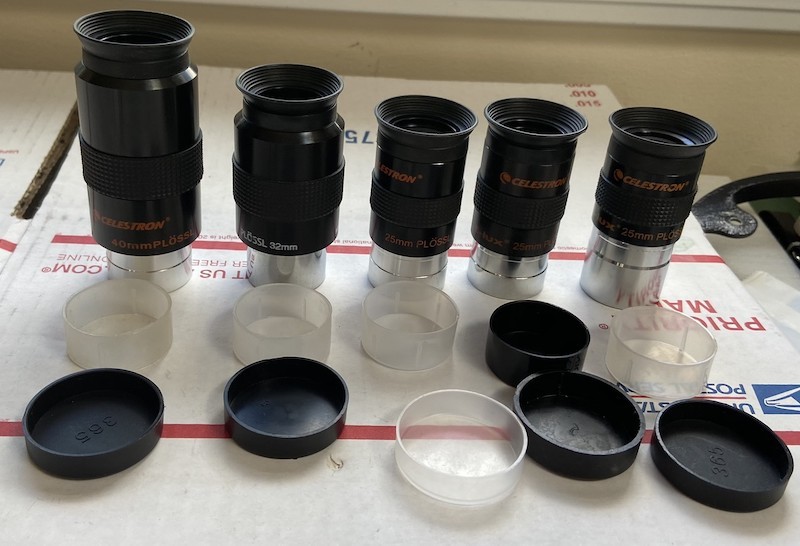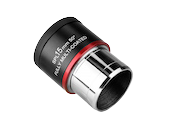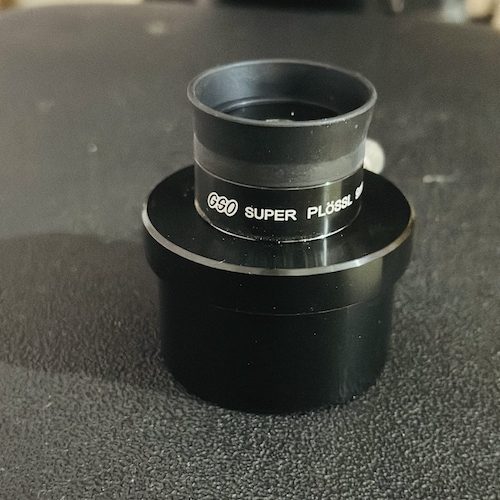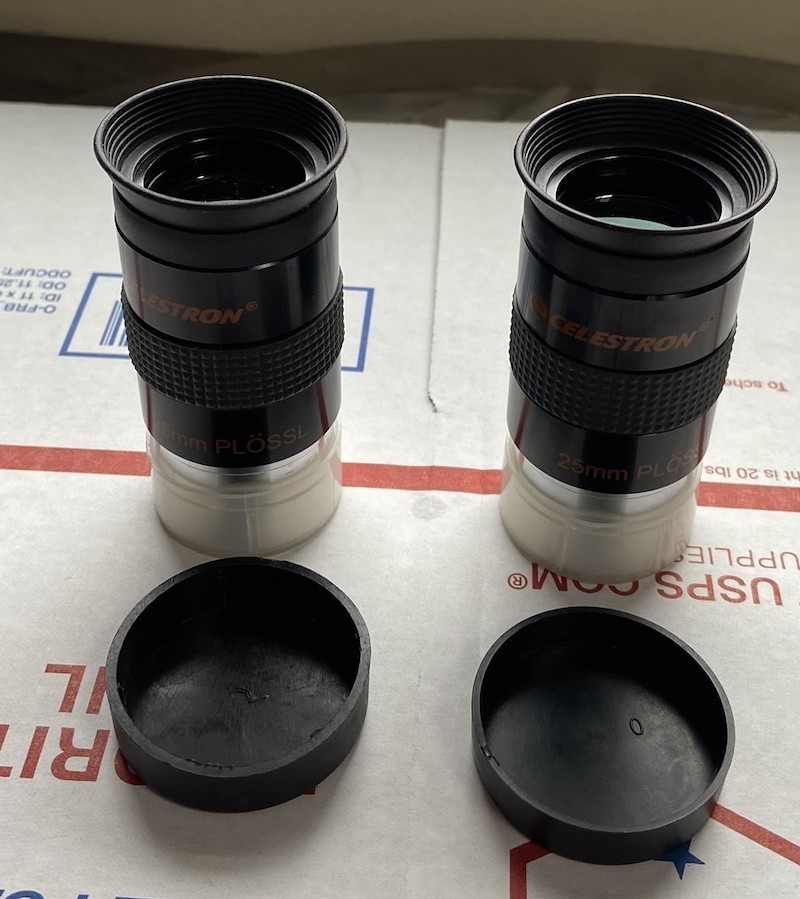
Plossl eyepieces used to be the gold standard for mid-tier eyepieces. Today, they’re often relegated to the status of “token” eyepieces thrown in with beginner telescopes. However, I still think there are some good reasons to use Plössls, and they are a lot less expensive than many other eyepiece designs.
Plossls have been around since the 1860s but only became common in the 1980s, when they were finally economical to manufacture and began outperforming Orthoscopic and Kellner eyepieces on then-new fast focal ratio telescopes like Dobsonians.
Most Plossls use four lens elements, each a pair of cemented lenses with convex and flat surfaces; the two convex surfaces face each other. Many Plossls are of the “symmetrical” type, with two identical pairs of lenses. Some add an additional lens element. That symmetry makes manufacturing cheap, and as such, Plossls are often bundled with many beginner telescopes or sold in kits.
Things to Look For in Plossl Eyepieces
- Field Of View
A typical Plössl achieves an apparent field of view no greater than about 52 degrees. Some long focal-length Plossl eyepieces can have a narrower field due to mechanical limitations imposed by the barrel diameter.
- Optical Performance and Multi-coating
I believe a good eyepiece should be fully multi-coated, meaning every lens surface has true multi-layer coatings. I’ve run into plenty of cheap eyepieces labeled as just “coated” or even “multi-coated” that actually lack coatings on some optical surfaces. Some are labeled “fully coated” but still have more reflections and less efficient light transmission, leading to more glare and dimmer images.
I also consider blackened lens edges, darkened interior barrels, and good baffling to be extremely important features—they help minimize glare and maximize contrast in a well-made eyepiece.
In my real-life usages, Plossl eyepieces provide sharp views with reasonably controlled aberrations in telescopes with focal ratios down to f/4 or so. However, their limited field of view can feel narrow, especially if you’ve used a wide-angle eyepiece or two.
- Possible Magnification Range
As always, no telescope can handle magnifications over about 50× per inch of aperture. And, in practice, atmospheric conditions or issues with the telescope’s optics, cooling, or collimation often limit me to quite a bit less than that, usually 300x or below. Similarly, on the low end, 4x magnification per inch of aperture is the lowest I can go due to our pupil’s limited diameter. Under light-polluted skies, I often use 5x or 6x per inch as a more appropriate limit. (Remember: magnification = telescope focal length ÷ eyepiece focal length—e.g., 1200 mm ÷ 10 mm = 120×.)
- Reputable Brands
Over time, I’ve learned that many cheap “Plossl” eyepieces are actually Kellner—or even worse—designs just masquerading as Plossls. These days, I always make sure the brand I’m buying from is reputable, and I stay away from shady, unknown brands on sites like Amazon. If it seems too good to be true, it probably is. I’ve also noticed that many manufacturers’ specs are purposely vague or talk about an entire series, even though each eyepiece might be very different.
Focal Lengths I’d Avoid
- Too Short (< 11 mm)
At focal lengths below about 11mm, the eye relief gets so short that viewing is impossible with eyeglasses on. Even without glasses, I found short focal-length Plossl eyepieces to be extremely uncomfortable to use.
I avoid Plossl eyepieces with focal lengths below 11mm and stick to other eyepieces that offer more comfortably sized eye lenses and longer eye relief. This is also why I never buy “eyepiece kits,” as they inevitably contain Plossls too short in focal length to actually use, and often they are also substandard in quality or provide us with redundant focal lengths of eyepieces.
- Too Long
Likewise, I steer clear of Plossls with focal lengths longer than 32mm in the 1.25” format (or 56mm in the 2” format), because at that point, the field of view is limited more by the eyepiece barrel itself than by the optical design. They don’t actually provide me a wider true field but instead a more straw-like view at lower magnification. That can also lead to an exit pupil that’s too big for our eyes to handle or a background sky that’s simply too bright. So I don’t bother with things like 40mm 1.25” Plossls or 60mm+ 2” Plossls.
Reliable Plossl Eyepieces I’ve Used and Liked
Extreme Performance Pick: TeleVue Plossls

The Tele-Vue eyepieces provide me excellent sharpness and contrast, even when I’m using fairly fast instruments, with minimal chromatic aberration, glare, and edge-of-field aberrations. They also work great with Tele-Vue’s Barlow lenses and other accessories.
The Next Best Plossls: Vixen NPL Series
The Vixen NPL eyepieces have high-quality optics. I also like how the longer focal length units of the NPL series use twist-up plastic eyecups, making them easy to grab and extremely comfortable to look through.
Best Value: SVBony SV207 Plossls

The SVBONY SV207 Plossls are high-quality eyepieces. They use comfortable, wide rubber eyecups that make viewing easy with or without glasses, and they offer slightly more eye relief than competing designs. I’ve been impressed by their excellent sharpness and overall value for the money.
Great Value: Apertura/GSO Plossls

The GSO Plossl eyepieces and many authorized resale brands such as Apertura are well-designed eyepieces with smooth, undercut-free barrels for easy insertion into focusers and star diagonals.
However, the short (<15mm) focal length versions were especially uncomfortable for me to look through and seemed to have a narrower field of view of below 50 degrees. The 15mm unit also has a fuzzy field stop, so the edge of the field of view does not cut off smoothly.
Similar to GSO/Apertura: Celestron Omni Plossls

The Celestron Omni Plossls felt optically and mechanically similar, if not identical, to the GSO designs in my experience, with the same pros and cons. These are not to be confused with the generic Plossl eyepieces thrown in Celestron’s kits or with beginner telescopes, which are quite a bit different. The “E-Lux” 25mm and 40mm Plossls are simply rebadged Omni Plossls, however.
As always, eyepieces are easy to switch out, and all of the ones on this list are well-known and come highly recommended. There’s nothing stopping you from buying eyepieces from different product lines depending on the price, focal length, and features you want.
